
Table of Contents
The 18 most common RV repairs address issues with plumbing, electrical systems, mechanical parts, and structural components. The repairs ensure that recreational vehicles, camper vans, and travel trailers remain safe, functional, and reliable for travel. RV repairs are a must to fix wear, malfunctions, or damage caused by regular use or improper storage. Leaks or small electrical faults, escalate into major issues like roof damage or engine failure without proper maintenance.
Routine camper repair and inspections save costs by preventing expensive repairs and maintaining the vehicle’s safety, performance, and longevity. Repair costs vary widely, from minor fixes like replacing a water pump for less than $100 to major repairs, such as roof replacements or engine overhauls, which cost thousands of dollars.
Preventative maintenance and proper storage are important to reduce the need for frequent travel trailer repairs. Cleaning the roof, sealing leaks, and inspecting tires help minimize wear and prevent breakdowns. Securing the RV in a climate-controlled facility, draining water systems, and disconnecting the battery protects the vehicle from weather damage, pests, and long-term deterioration.
The proactive measures extend the RV’s lifespan, reduce repair costs, and enhance travel comfort, ensuring that RV owners enjoy safe and worry-free journeys for years.
The Top 5 Common RV Repairs are listed below.
- Roof Repairs: Roof Repairs are common due to weather exposure and require resealing or patching to prevent water damage.
- Plumbing Repairs: Plumbing Repairs include fixing leaks, clogged drains, or damaged water pumps, and plumbing resolved with part replacements or inspections.
- Electrical System Repairs: Electrical System Repairs address issues like blown fuses, faulty outlets, or dead batteries, which are fixed by replacing damaged components.
- Slide-Out Repairs: Slide-Out Repairs are needed for mechanisms malfunctioning or failing to extend/retract properly, requiring adjustments.
- HVAC System Repairs: HVAC System Repairs involve problems with heating, cooling, or ventilation systems, resolved by diagnosing and replacing faulty parts.

1. Roof Repairs
Roof repairs in RVs address leaks, cracks, or punctures caused by weather exposure, aging materials, or physical damage. Symptoms include water stains on the ceiling, mold growth, or soft spots on the roof. Problems are common due to constant exposure to elements and require moderate fixing effort. Costs range from $379 to $1,763 for minor resealing to over $9,117 for complete roof replacements, depending on the severity of the damage.
Regular inspections are required, at least twice a year, to prevent extensive damage by identifying early signs of wear. Maintaining proper sealants and promptly addressing minor issues extend the roof’s lifespan.
Neglecting roof maintenance leads to severe water damage, affecting the RV’s structural integrity and usability. Common tools for roof repairs include sealant applicators, patch kits, and cleaning supplies. The time for roof repairs varies from a couple of hours for minor fixes to a few days for major overhauls, depending on the repair’s complexity.
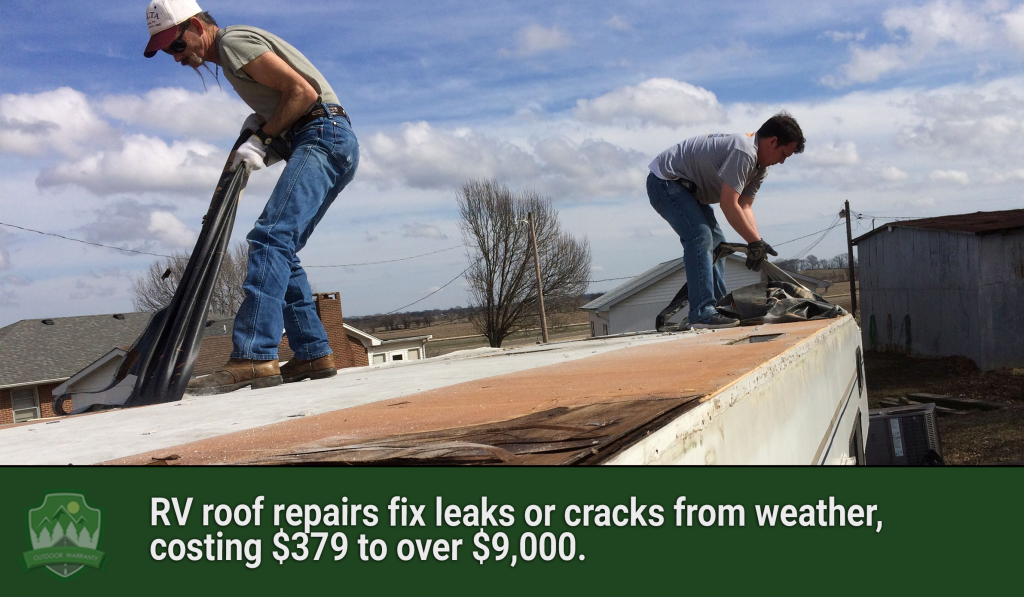
2. Plumbing Repairs
Plumbing repairs in RVs involve fixing leaks, unclogging drains, or replacing damaged water pumps. Causes of repair include freezing temperatures, wear and tear, or high water pressure. Symptoms manifest as water stains, reduced water pressure, or unusual noises from the pump. Plumbing issues are common and range from simple fixes to more complex tasks.
Costs range from $180 to $600, depending on the problem’s severity and the parts required. Preventive measures include winterizing the plumbing system before cold weather, using a water pressure regulator, and performing regular system checks.
Ignoring plumbing upkeep causes water damage and disrupts essential functions, such as access to running water. Plumbers commonly use wrenches, pipe sealants, and replacement hoses. Minor fixes for repair take a few hours, while more complex problems take a full day or longer to resolve.
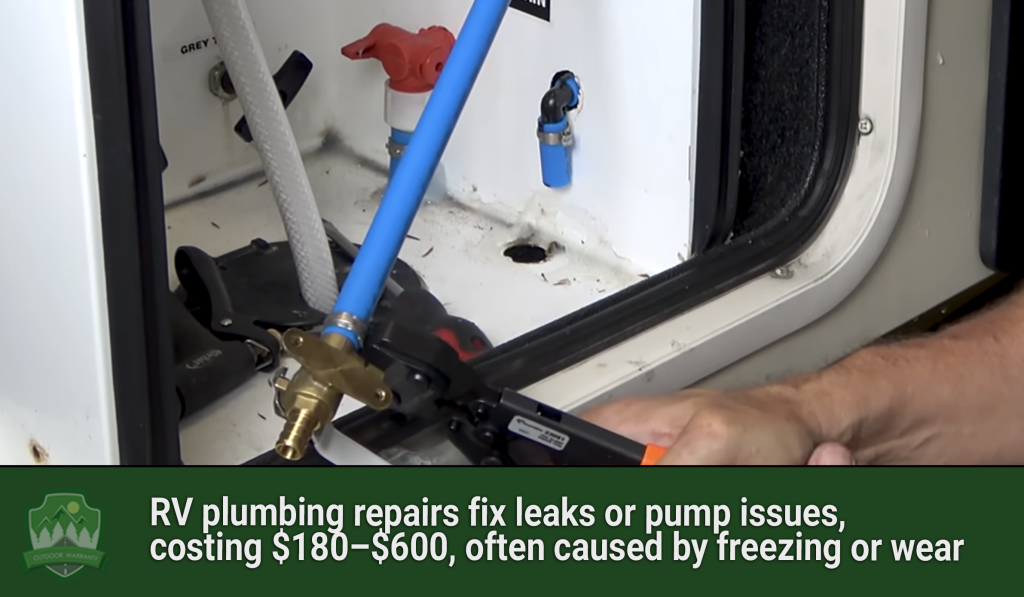
3. Electrical System Repairs
Electrical system repairs in RVs focus on fixing issues like blown fuses, faulty outlets, and dead batteries. Problems are caused by overloaded circuits, aging parts, or loose connections. Symptoms include flickering lights, appliances not working, or a complete power loss. Electrical issues are common in RVs due to the system’s complexity and frequent use. Repairs range from simple fixes, such as replacing a fuse for $50 to $350, to extensive rewiring, costing over $1,000.
An RV’s electrical system consists of two power sources, a 12-volt DC system and a 120-volt AC system. The 12-volt DC system runs essential functions like lights, water pumps, and fans, drawing power from the RV’s batteries. The 120-volt AC system powers larger appliances like air conditioners, refrigerators, and microwaves when connected to shore power or a generator.
A converter connects the systems, allowing the battery to charge and ensuring the systems work together smoothly. Regular inspections, using appliances within limits, and replacing worn components help prevent issues.
Electric repairs require tools like multimeters and wire strippers, with simple fixes taking a few hours and more complex maintenance requiring days to complete.
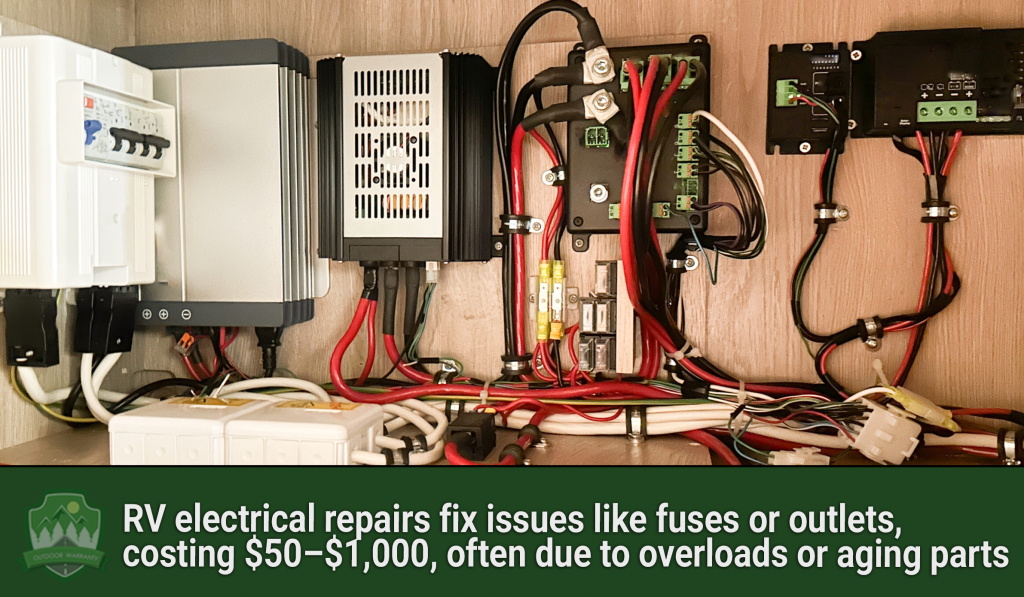
4. Slide-Out Repairs
Slide-out repairs fix problems with the mechanisms that move the slide-out sections of an RV, which are essential for creating more living space. Common causes include motor failures, misaligned tracks, damaged gears, or hydraulic system leaks in hydraulic slide-outs models.
Symptoms or issues of slide-outs include uneven or jerky movement, grinding or unusual noises during operation, visible gaps or misalignment, and complete failure to extend or retract.
The issues in slide-out occur due to wear and tear, debris buildup, or improper use. Repairs for slide-out are complex because of diagnosing motor problems, replacing tracks, or addressing hydraulic system failures.
Slide-out repairs range from $500 for minor issues, such as track adjustments, to over $5,000 for major repairs, like motor or hydraulic system replacements. Regular maintenance, including lubricating moving parts, inspecting seals for wear, and keeping the slide-out mechanism clean, helps prevent common issues.
Repairs for slide-outs require specialized tools like slide-out stabilizers, alignment gauges, and hydraulic repair kits, and professional services are required for complex problems. Simple fixes take a few hours, while extensive repairs involving major components require a few days.
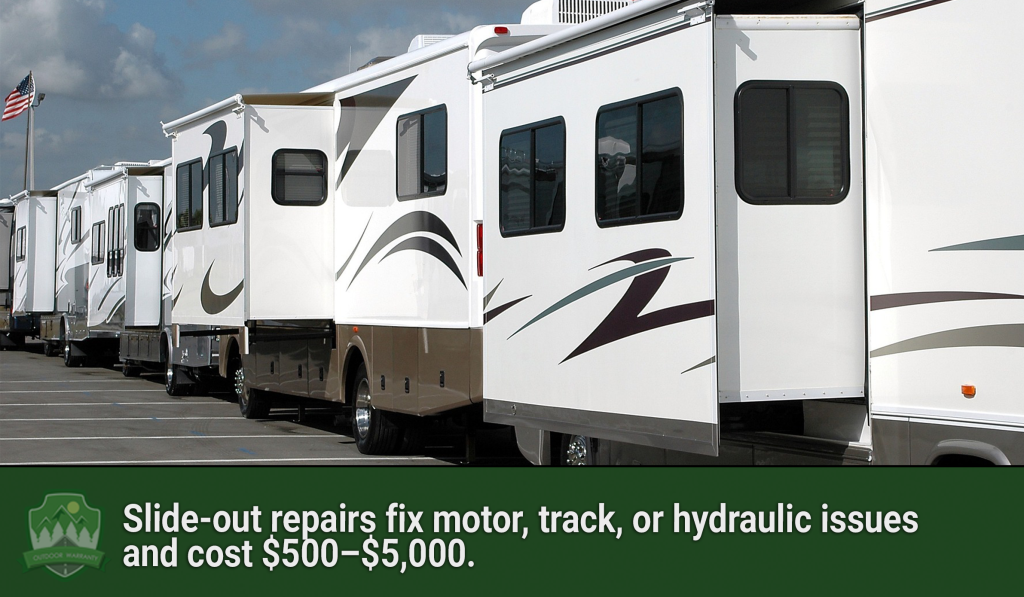
5. HVAC System Repairs
HVAC system repairs or Heating, Ventilation, and Air Conditioning in RVs focus on fixing issues with heating, ventilation, and air conditioning units. Common causes or issues include refrigerant leaks, faulty thermostats, or worn-out components. Symptoms in the HVAC system include poor temperature control, unusual noises, and reduced airflow. Clogged filters, electrical failures, refrigerant leaks, and thermostat malfunctions frequently lead to inconsistent heating or cooling. Modern RV air conditioning systems use R-410A refrigerant, which operates at higher pressures than older R-22 systems, making proper maintenance essential. Repair costs range from $130 for minor issues to $2,000 for major component replacements.
Regular maintenance, such as cleaning filters and inspecting components, helps to prevent issues. Timely replacing worn parts and ensuring the system functions correctly help extend its lifespan.
A malfunctioning HVAC system causes discomfort and severely reduces the RV’s span in extreme temperatures. Screwdrivers and multimeters are used for minor repairs, while more complex issues involving refrigerant or high-pressure systems require professional services.

6. Propane System Repairs
Propane system repairs involve fixing leaks, replacing regulators, or addressing issues with appliances that run on propane. Causes include aging components, loose connections, or damaged hoses.
Symptoms of propane repair are the smell of gas, appliance malfunctions, or hissing sounds. The issues are less common but critical due to safety concerns.
The cost of repairing an RV propane system depends on the issue and the parts required. For example, a full RV service, including a propane leak test, costs around $25 at service providers. Basic maintenance, such as propane system inspections, costs between $100. The prices vary based on the complexity of the repair and labor costs.
Prevent propane system issues through regular inspections for leaks, ensuring connections are tight, and replacing aging components. Neglecting propane system maintenance leads to hazardous situations and loss of essential functions like cooking or heating. Tools for propane system repairs, such as leak detection solutions and wrenches, are commonly used, but professional services are recommended.

7. Brake and Suspension Repairs
Brake and suspension repairs are important for maintaining an RV’s safety and ride comfort. The braking system includes components like pads, rotors, and calipers, while the suspension system comprises parts such as shocks, struts, and leaf springs. Common causes of brake repairs include regular use wear and tear, exposure to harsh road conditions, and infrequent maintenance.
Symptoms involve grinding noises during braking, a spongy brake pedal, uneven tire wear, or a rough ride. Regular inspections for breaks are recommended because brake pads require replacement every 12,000 to 15,000 miles, depending on driving habits and conditions.
Brake and suspension repairs differ in complexity based on the problem. Replacing brake pads is a process that takes one to two hours, with costs ranging from $250 to $800, depending on parts and labor. Suspension repairs are more complex because of multiple components. A routine suspension inspection costs between $1,000 to $5,000.
Specific replacements come with additional costs. Replacing a shock absorber ranges from $200 to $1,500. A coil spring replacement costs $550 to $700. Strut replacement ranges from $50 to $900, and wheel alignments cost $20 to $400. The tools and expertise needed for the break repair require professional service.
Failing to repair brake and suspension systems reduces braking performance and weakens vehicle handling, creating safety hazards.
Tools for brake repairs include wrenches, brake caliper tools, and jacks. Repairs take 2 to 4 hours, while suspension repairs take longer based on the extent of the damage.
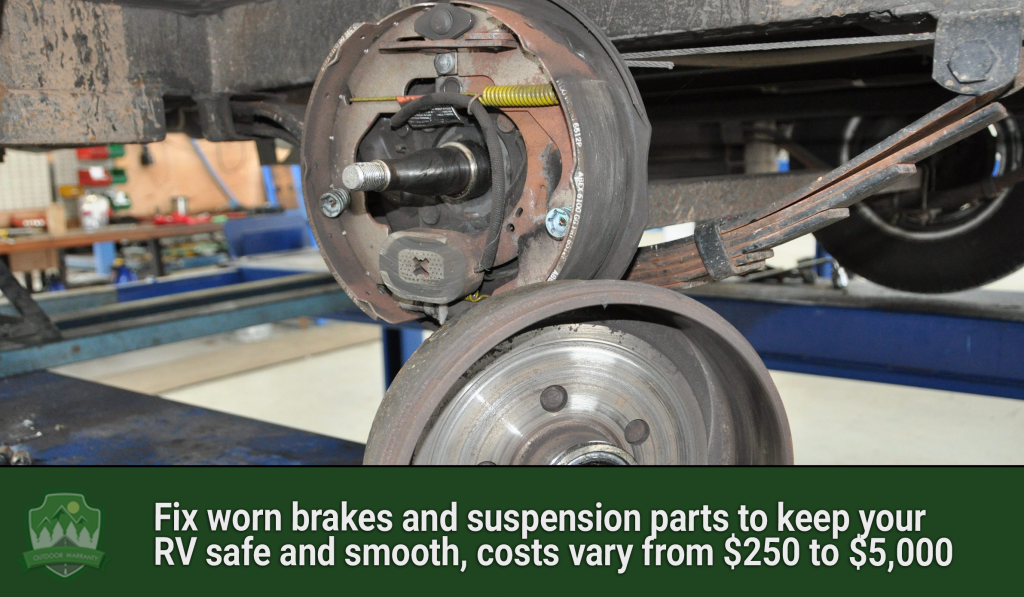
8. Tire Repairs and Replacement
Tire Repairs and Replacement are for RV safety and performance. The common issues that demand tire repairs or replacements include tread wear, punctures, and sidewall damage. Factors contributing to the tire repair problems encompass overloading, improper inflation, and prolonged exposure to the outside.
Signs of tire issues include visible cracks, bulges, uneven tread wear, or decreased traction. Owners must inspect tires before each trip and replace them every 5 to 7 years, regardless of mileage.
Replacing RV tires is moderately complex, requiring specialized equipment. The repair cost varies based on the RV class, Class A motorhome tires average around $300 to $350 per tire, while Class B and C motorhome tires range from $200 to $300 per tire. Preventive measures include maintaining proper tire pressure, regular rotations, and protecting tires from UV exposure using covers.
Failing to maintain tires increases the risk of blowouts, which create serious safety risks and damage the RV. Common tools for tire maintenance include a tire pressure gauge, torque wrench, and jack.
Installing and balancing new tires requires professional assistance. Replacing tires takes 1 to 2 hours, depending on the number of tires and the service provider’s efficiency.
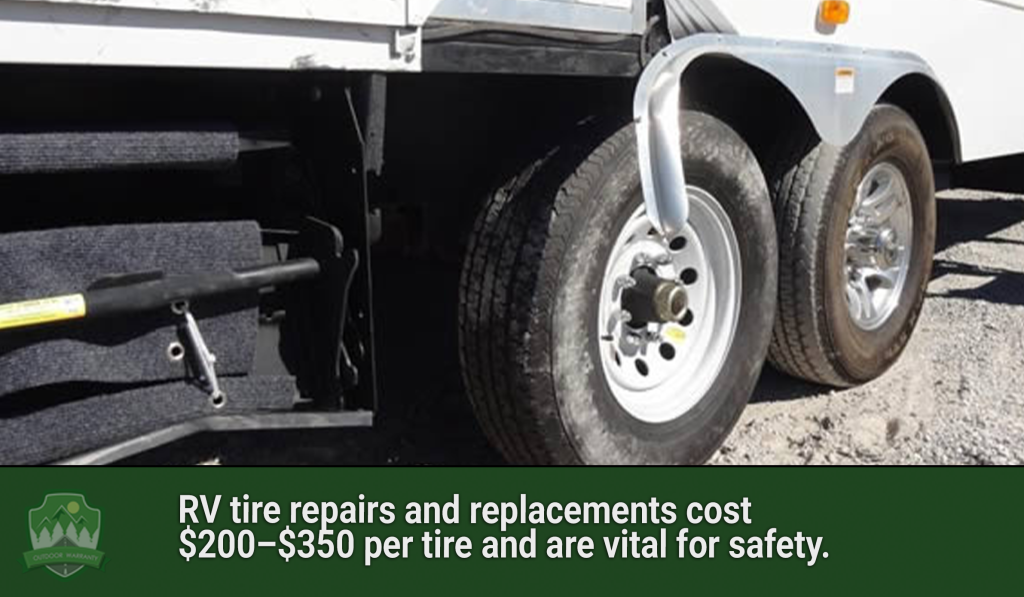
9. Appliance Repairs
Appliance repairs, including issues with refrigerators, stoves, and microwaves, are essential for maintaining comfort when traveling. Common appliance issues involve component failures, electrical problems, or wear from regular use. Causes range from power surges and improper usage to aging parts.
Symptoms or issues include appliances not powering on, inconsistent performance, or unusual noises. The frequency of repairs depends on appliance usage and maintenance, but the repair is occasional.
Appliance repairs have different levels of difficulty. Appliances that have issues are fixed by replacing a fuse, while others need specialized knowledge. Repair costs range between $100 and $500, depending on the appliance and the severity of the problem. The repair times range from 1 to 3 hours, depending on the appliance and issue.
Preventive measures include regular cleaning, following manufacturer guidelines, and using surge protectors to prevent electrical damage. Malfunctioning appliances impact the usability of the RV by reducing comfort and convenience.
Common tools for appliance repairs include screwdrivers, multimeters, and replacement parts. Professional services are required for complex issues or when dealing with gas-powered appliances.

10. Exterior Body Repairs
Exterior Body Repairs of an RV are liable to damage from various sources, including accidents, weather exposure, and debris impact. Common repairs involve addressing dents, scratches, and delamination. Causes for exterior body repair include collisions, hailstorms, and prolonged exposure to UV rays, leading to material degradation.
Symptoms of exterior damage are visible imperfections, water leaks, or bubbling of exterior panels. The frequency of the repairs depends on driving conditions and storage practices, but it is rare.
Exterior body repairs range from simple touch-ups to complex structural fixes. Minor repairs cost between $50 and $200. Repairing delamination or fixing water intrusion caused by panel separation cost $850 to $3,000 for more extensive damage
Severe structural damage from accidents exceeds $5,000 if frame or roof sections require replacement. Preventive measures include using RV covers, regular cleaning, and cautious driving to avoid collisions. Damage to the exterior affects the RV’s appearance and leads to issues like water intrusion, and common tools for repairs include body filler, sanders, and paint.
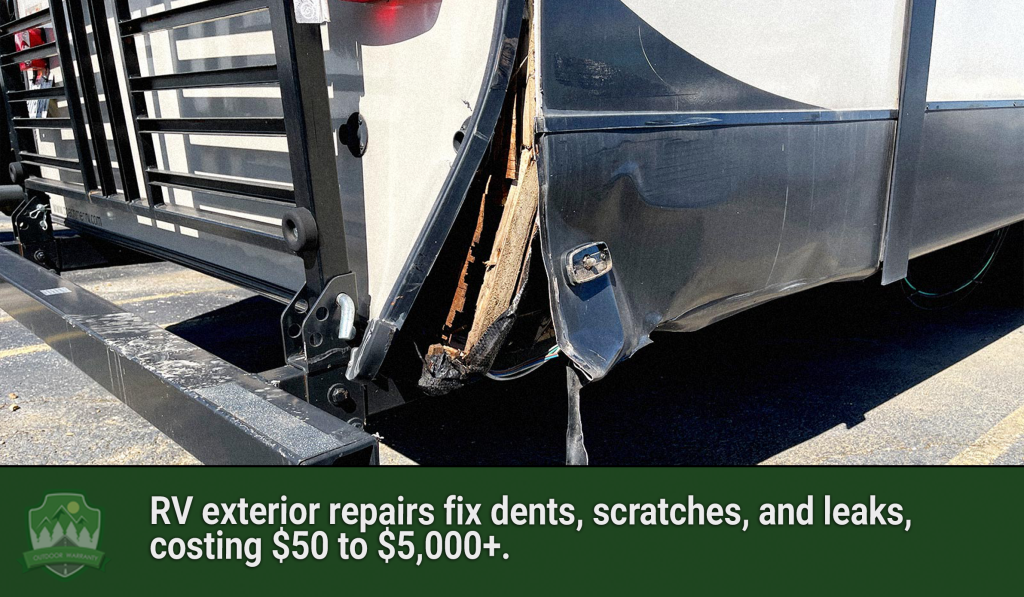
11. Window and Door Repairs
Windows and doors in an RV are critical for security, insulation, and accessibility. Common issues include broken latches, misaligned frames, and seal failures. Causes are wear and tear, improper usage, or exposure to harsh weather conditions.
Symptoms involve drafts, water leaks, difficulty opening or closing, and rattling noises during travel. The frequency of the repairs varies but tends to increase with the RV’s age and usage.
Repair complexity ranges from simple latch replacements to more involved tasks like resealing or realigning frames. Costs are minimal for minor repairs, such as $50 for a new latch, but escalate to a hundred dollars for window replacements.
Preventive measures include regular lubrication of moving parts, inspecting seals, and gentle operation to avoid undue stress. Faulty windows and doors compromise the RV’s security and energy efficiency.
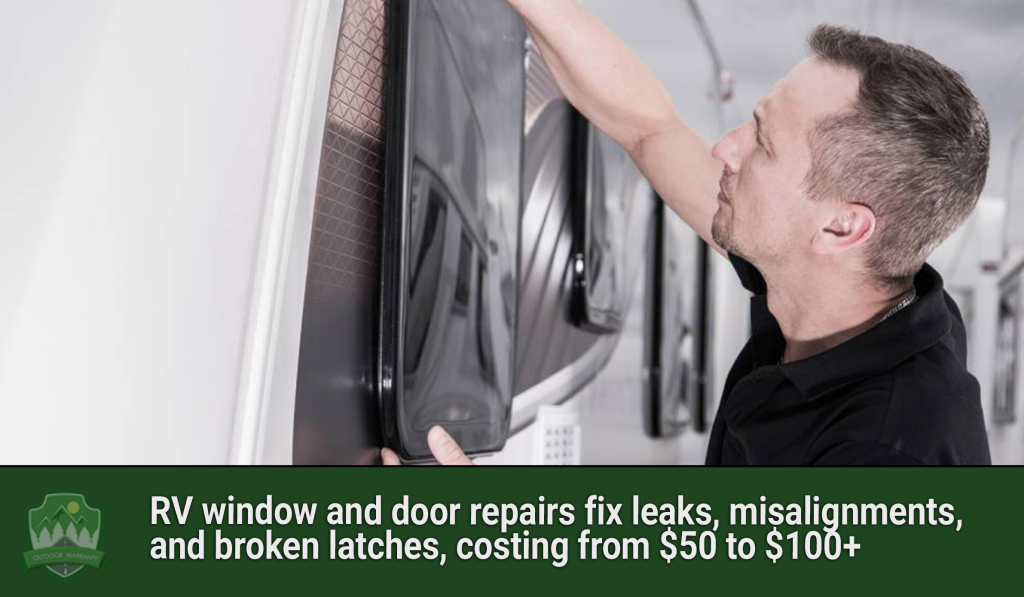
12. Generator Repairs
Generator repairs are essential for powering appliances and systems when external power sources are unavailable. Common issues for generators requiring repair include difficulty starting, inconsistent power output, and unusual noises during operation. The problems stem from factors such as fuel contamination, or lack of regular maintenance.
Symptoms manifest as the generator failing to start, fluctuating power levels, or unexpected shutdowns. Regular use and exposure of generators to varying environmental conditions lead to the issues over time.
The complexity of generator repairs varies, replacing a fuel filter are straightforward, while overhauling the fuel system is more involved.
Repair costs range from $100 for minor fixes to over $1,500 for major repairs, depending on the generator’s make and model. Preventive measures include routine maintenance, such as oil changes, air filter replacements, and running the generator periodically to keep components lubricated.
Failing generator maintenance results in power outages, which disrupt essential RV systems such as lighting, heating, and appliances. Repairing a generator involves using tools like wrenches, multimeters, and fuel pressure gauges to diagnose and fix issues.
Professional assistance is required for more complicated problems to ensure the repairs are done correctly. Repair times take between 1 and 4 hours, depending on the issue.
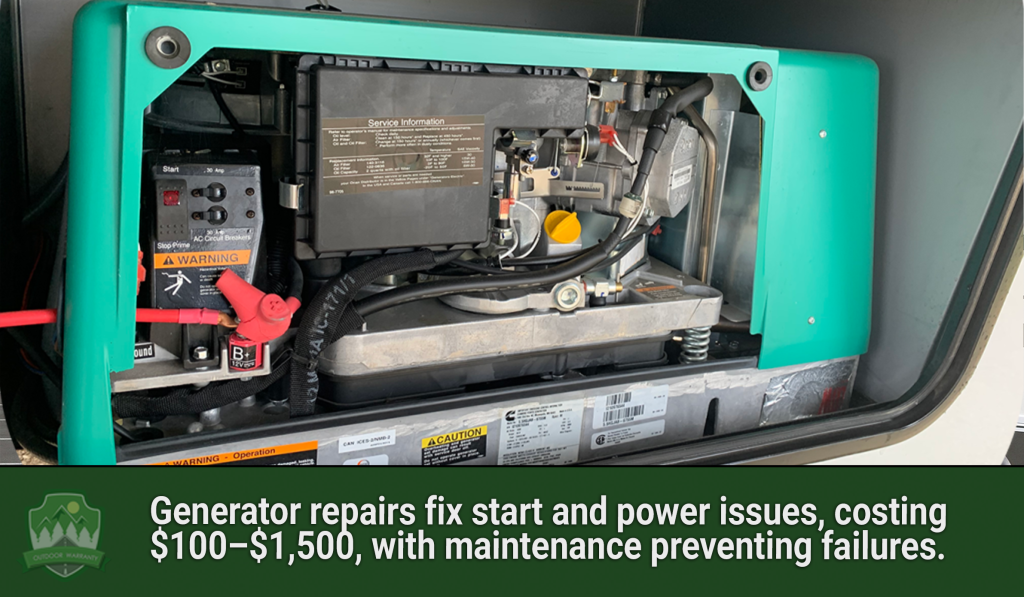
13. Waste System Repairs
The waste system in an RV manages the collection and disposal of gray and black water. Common issues include clogged drains, leaking tanks, and malfunctioning valves. Causes of these problems range from improper disposal of waste materials to wear and tear on seals and fittings. Symptoms include unpleasant odors, slow drainage, or visible leaks. Water waste issues occur occasionally in older RVs or with high usage.
Clearing a simple clog is easy while replacing a waste tank is more complex. Costs for waste system repairs range from $100 for minor clogs to over $1,500 for major component replacements.
Preventive measures include using RV-friendly toilet paper, regular tank cleaning, and proper waste disposal practices. Failing to maintain the waste system results in unsanitary conditions and strong odors, which reduce the comfort and usability of the RV.
Basic tools for addressing the problems include plungers, pipe wrenches, and sealant. Professional assistance is needed to complete extensive repairs or replacements for more serious issues. Repairs take anywhere from 1 to 5 hours to complete, depending on the complexity of the problem
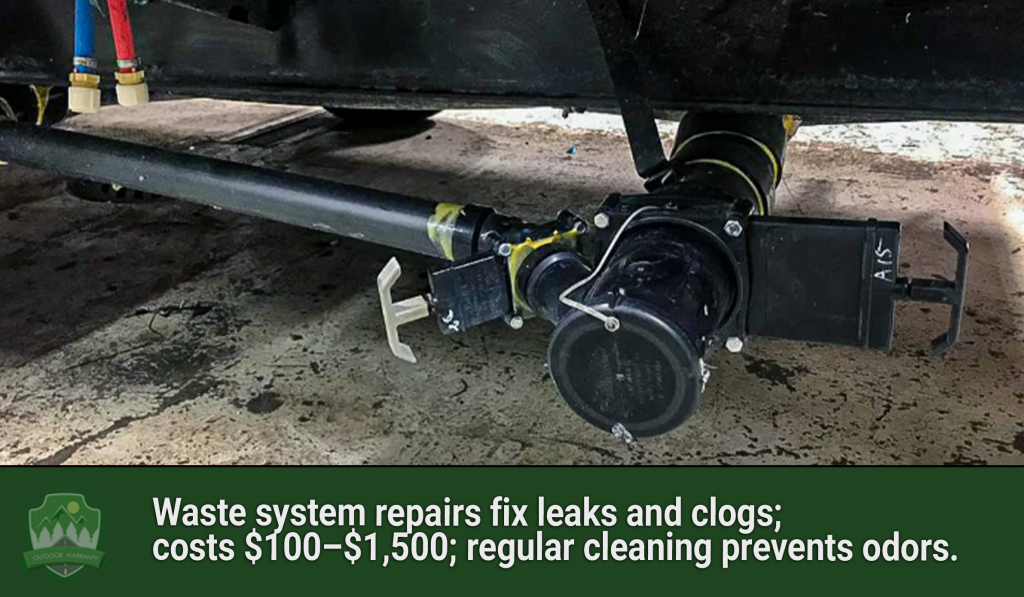
14. Battery Maintenance and Replacement
Battery maintenance and replacement are essential for functional RV systems, including lighting and appliances. Common issues include reduced battery capacity, corroded terminals, and the inability to hold a charge.
The problems with battery maintenance are caused by aging, overcharging, or long periods without use. Symptoms of battery trouble include dim lights, slow appliance performance, or difficulty starting the RV engine. Battery issues are more frequent in older batteries or are poorly maintained.
The basic battery maintenance tasks, such as cleaning terminals and checking electrolyte levels, are simple and take little time while replacing a battery is slightly more complex.
Replacement of the battery costs range from $100 to $500, depending on the type and capacity of the battery. Preventive steps include regular inspections, charging the battery, and ensuring secure connections. Failing battery care leads to power loss, disrupting critical RV functions. Wrenches, battery terminal cleaners, and multimeters are required to repair or maintain the battery.
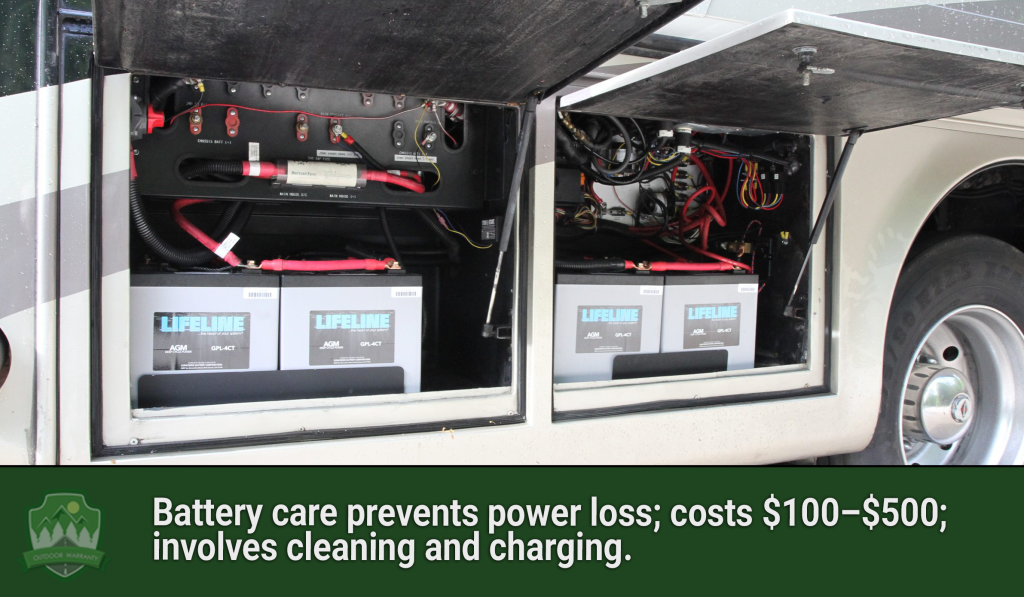
15. Awning Repairs
Awning repair in RVs requires repairs for fabric tears, damaged support arms, or malfunctioning retraction mechanisms. Repair issues are caused by harsh weather, improper use, or accidental damage and show symptoms like difficulty retracting visible tears or instability.
Awning repairs range from patching fabric to fixing mechanical parts, with costs between $100 for minor fixes and up to $2,500 for full replacements.
Regular cleaning, proper storage, and avoiding extreme weather help prevent damage, and neglecting the repair maintenance reduces outdoor usability and risks damage. Awning takes 1 to 4 hours and requires tools like wrenches, screwdrivers, or replacement parts, with professional services needed for complex repairs.
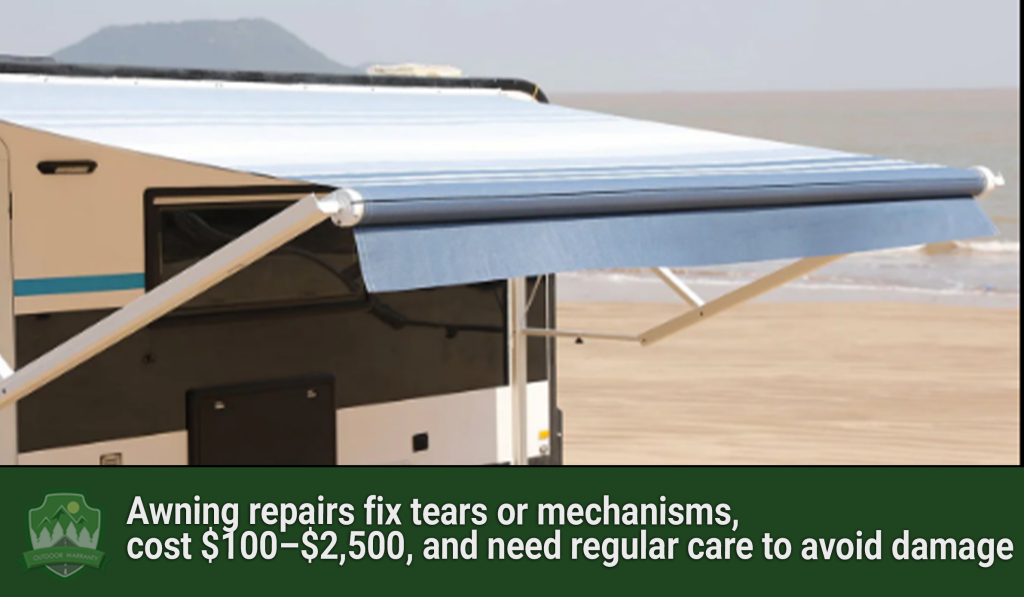
16. Engine and Drivetrain Repairs
Engine and drivetrain repairs are essential for an RV’s mobility and arise from overheating, transmission slipping, or differential noise. Insufficient maintenance and fluid leaks cause the issues for engine repairs.
Symptoms include warning lights, unusual noises, or reduced performance, with issues becoming more frequent in older or poorly maintained vehicles.
Repairs require specialized tools like diagnostic scanners, lifting equipment, and professional expertise. Costs range from $1,000 for minor fixes to over $3,000 for major overhauls. Preventive measures, such as regular fluid changes and prompt attention to problems, help reduce the risk of breakdowns.
Neglecting the engine and drivetrain leads to severe downtime and costly repairs, with repair times varying from a few hours to a few weeks based on the severity of the issue.

17. Winterization Repairs
Winterization repairs protect RV systems from freezing weather damage. Common issues include frozen water lines, cracked tanks, and appliance failures due to ice expansion.
Improper sealing leads to drafts and higher energy use, while neglected batteries lose lifespan in cold conditions. Repairs involve draining water lines, using RV antifreeze rated for temperatures as low as -50°F, and sealing gaps to block cold air.
Costs range from $100 to $500, depending on RV size and needed services. Routine checks, antifreeze use, and proper sealing help prevent costly repairs. The process of RV Winterization, which takes a few hours, requires tools like wrenches, sealant, and antifreeze. Proper winterization ensures the RV stays functional and avoids damage in freezing conditions.
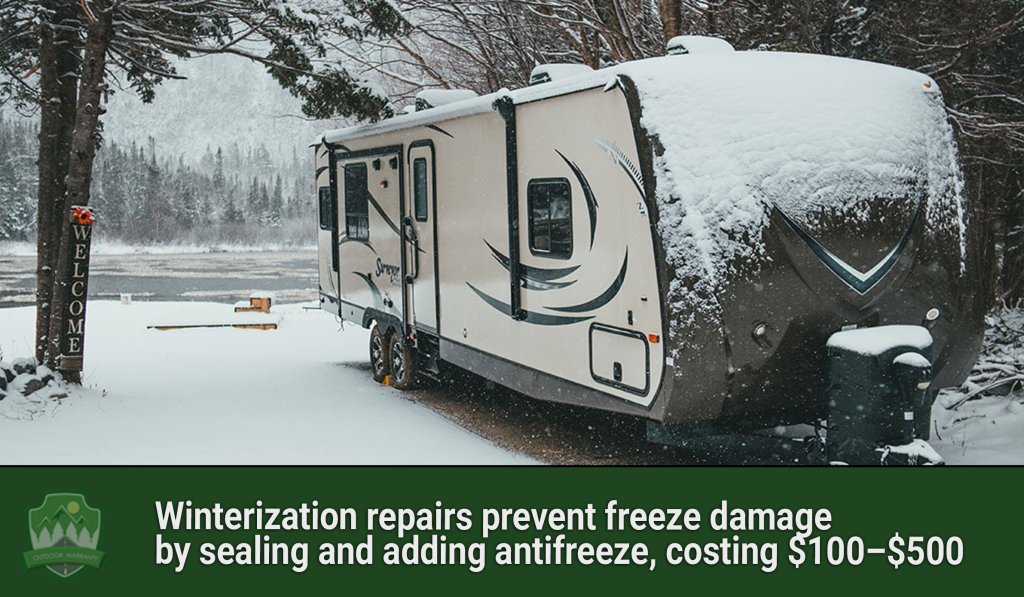
18. Slide-Out Seal and Motor Issues
Slide-out seal and motor issues affect the expandable sections of an RV that provide additional living space. Problems include damaged seals leading to water leaks and faulty motors causing improper slide operation. Causes are age-related wear, debris accumulation, and electrical failures. Symptoms involve water ingress, drafts, unusual noises, or the slide-out failing to extend or retract smoothly. In older RVs that lack regular maintenance, the issues occur periodically.
Seal replacements cost between $50 and $200, while motor repairs or replacements range from $150 to $700, depending on the model and labor involved. Preventive measures include regular cleaning and lubrication of seals, inspecting for wear, and ensuring the slide-out mechanism remains debris-free.
Addressing the issues maintains the RV’s comfort and prevents further damage. Common tools required are sealant applicators, lubricants, and basic hand tools, and professional services are required for motor-related repairs. Repair times vary from one to a few hours based on the issue’s complexity.
High-quality slide-out seals are made from Ethylene Propylene Diene Monomer (EPDM) rubber, resistant to UV rays and extreme temperatures, increasing slide-out durability.
Advanced slide-out systems now include electronic sensors that stop movement if an obstruction is detected, reducing the risk of motor damage. Regular cleaning, lubrication, and inspections are important to keep slide-outs functioning properly and to avoid costly repairs Despite the advancements.
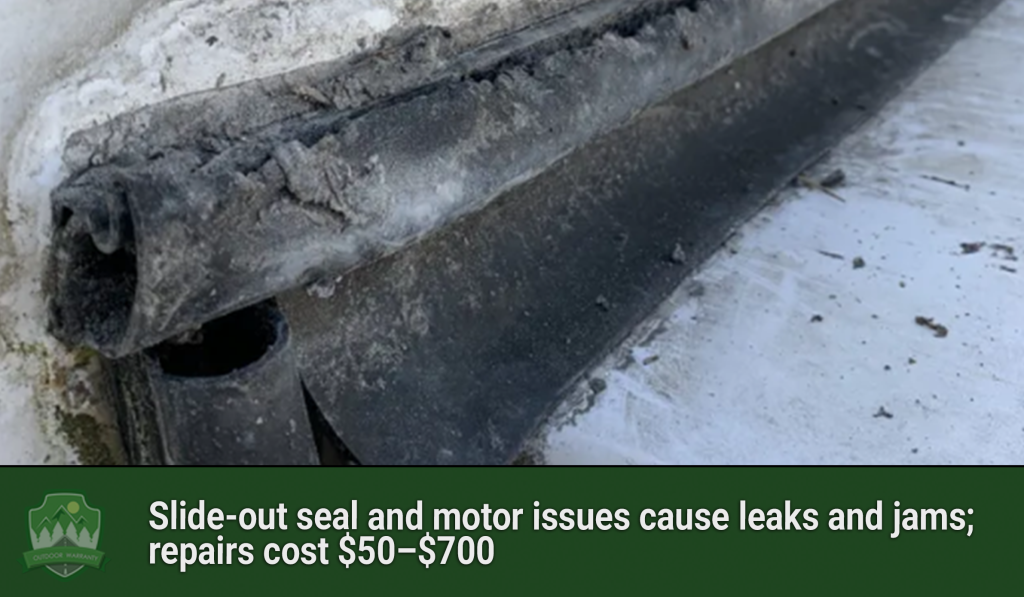
Why RVs Need Repairs?
Recreational vehicles (RVs) need repairs due to factors like continuous travel that lead to wear and tear on mechanical components, such as engines and brakes. Exposure to weather elements causes deterioration of exterior surfaces and seals.
Frequent use of onboard systems increases the likelihood of malfunctions. An average of 4,200 RV fires were reported annually, resulting in approximately 15 deaths, 125 injuries, and $60.3 million in property loss from 2018 to 2020.
Mechanical, structural, and electrical systems in RVs commonly need attention. Mechanical issues involve engine repairs or brake replacements. Structural problems include roof leaks or frame damage. Electrical faults affect lighting, appliances, or power distribution. 17,360 RV service technicians are employed in the United States, highlighting the sector’s demand for maintenance and repair services.
Scheduled inspections allow owners to identify problems early, such as worn brake pads, loose wiring, or deteriorating seals, before small repairs cause severe damage. Cleaning and resealing the roof every six months prevent water leaks that lead to structural damage. Checking tire pressure and alignment regularly helps avoid blowouts and improves fuel efficiency.
Ignoring routine maintenance increases repair costs and shortens the RV’s lifespan. For example, electrical system neglect raises the risk of fire, showing thousands of RV fires annually. Keeping all systems in good condition enhances safety, improves reliability, and maintains the resale value of the RV. A consistent maintenance schedule is essential for safe and enjoyable travel experiences.
Are Camper Trailer Repairs Less Expensive than Motorhome Repairs?
Yes. Camper trailer repairs are less expensive than motorhome repairs. The cost difference arises from the complexity of the systems involved. Motorhomes join living quarters and a vehicle engine, leading to more complicated systems that require specialized maintenance. Engine repairs in motorhomes range from $1,400 to $30,000, depending on the severity of the issue. Travel trailer repair focuses mainly on the living space, lacking an engine, which simplifies maintenance and reduces associated costs.
Size, features, and repair frequency influence the cost variations. Motorhomes, being larger and more feature-rich, encounter more frequent and costly repairs. For example, motorhome transmission repairs cost between $1,900 and $12,000, while the common repairs for travel trailers, like roof air conditioning unit replacements, cost between $600 and $3,500. The difference in repair expenses makes camper trailers a more economical choice for many RV owners.
Given the potential high costs of motorhome repairs, RV owners consider a Motorhome Extended Warranty to mitigate unexpected expenses. Such warranties cover various mechanical components, offering peace of mind during travels.
Can Extended RV Warranties include RV Repairs?
Yes. Extended RV warranties include RV repairs, which cover a wide range of mechanical and electrical repairs. The plans include components like engines, transmissions, drive axles, steering, and electrical systems. Appliances such as air conditioners, water heaters, and slide-out mechanisms are covered under certain plans. Coverage varies depending on the specific plan and provider for Extended RV Repairs.
Extended RV warranties have exclusions, including routine maintenance, wear-and-tear items, and non-mechanical components like upholstery and paint. Damage resulting from accidents or misuse is not covered.
Reading the warranty terms carefully is important to understand what is and is not covered. It ensures that there are no surprises when a repair is needed. Having an extended warranty provides financial protection against unexpected repair costs. It offers peace of mind, knowing that many potential issues are covered. Warranties allow RV owners to enjoy their travels without worrying about unforeseen expenses.
What is the Importance of RV Maintenance?
The importance of RV maintenance ensures its ability to prevent costly repairs and safety, and extend the vehicle’s lifespan. Regular maintenance helps identify small issues, such as worn brake pads or low fluid levels. Ignoring maintenance leads to major issues, such as engine failure, water damage, or brake malfunctions, compromising safety and requiring expensive repairs, causing RV problems. Proper care ensures the RV is reliable, safe to drive, and ready for every trip.
Essential maintenance tasks include oil changes, tire inspections, brake checks, and winterization. For example, failing to change the oil causes engine overheating and permanent damage, leading to costly repairs.
Winterizing protects the RV from freezing temperatures, preventing water lines and tanks from cracking. Regular maintenance improves performance and increases the RV’s longevity and resale value. Following a consistent maintenance schedule is important to keeping the RV in top condition and avoiding expenses. Neglecting routine care results in unexpected breakdowns, which ruin travel plans and create stressful situations.
Checking the battery, seals, and electrical connections helps prevent failures on the road. Cleaning and inspecting the roof prevents leaks that cause interior damage and keeping the tires properly inflated and aligned reduces the risk of blowouts and uneven wear. Monitoring fluid levels and filters improves engine efficiency and fuel economy. A well-maintained RV provides a comfortable and enjoyable experience for travelers. Regular servicing by a professional ensures that all systems function properly and increases overall safety.
What are the Benefits of RV Storages?
The benefits of RV Storages are listed below.
- Protection from Weather: Protection from weather benefits RV storage, shielding vehicles from harsh elements like sun, rain, and snow. It prevents damage such as fading paint, water leaks, and rust, helping to preserve the RV’s exterior.
- Security Benefits: Security Benefits are provided by RV storage facilities, which use features like surveillance cameras, gated access, and on-site personnel. The measures help protect RVs from theft and vandalism, offering peace of mind to owners.
- Space-Saving Advantages: Space-Saving Advantages make RV storage facilities helpful in freeing up driveways and yards at home. It allows homeowners to reclaim space for other activities or vehicles.
- Compliance with Local Regulations: Compliance with Local Regulations is ensured by storing RVs off-site in areas where parking restrictions exist. Neighborhoods prohibit large vehicles, and using a storage facility helps avoid fines and conflicts with local laws.
- Additional Services: Additional Services offered by RV storage facilities include climate-controlled units, vehicle maintenance, and cleaning stations. These amenities help keep the RV in good condition and ready for use.
- Maintaining Vehicle Condition: Maintaining Vehicle Condition is easier with proper storage, as RVs are protected from weather, pests, and environmental damage. Regular upkeep provided at some facilities extends the lifespan of the RV.
- Insurance Benefits: Insurance benefits are linked to using secure RV storage, and insurance companies offer discounts for storing vehicles in protected facilities. Benefits reduce the cost of RV ownership while ensuring proper coverage.
- Convenience for Travel: Convenience for Travel is a benefit of storing RVs near popular destinations or highways. It reduces travel time and simplifies trip planning for frequent RV users.
- Pest Prevention: Pest Prevention is an advantage of dedicated storage, as facilities have measures to keep out rants and insects. It protects the RV’s interior and systems from potential infestations and damage.
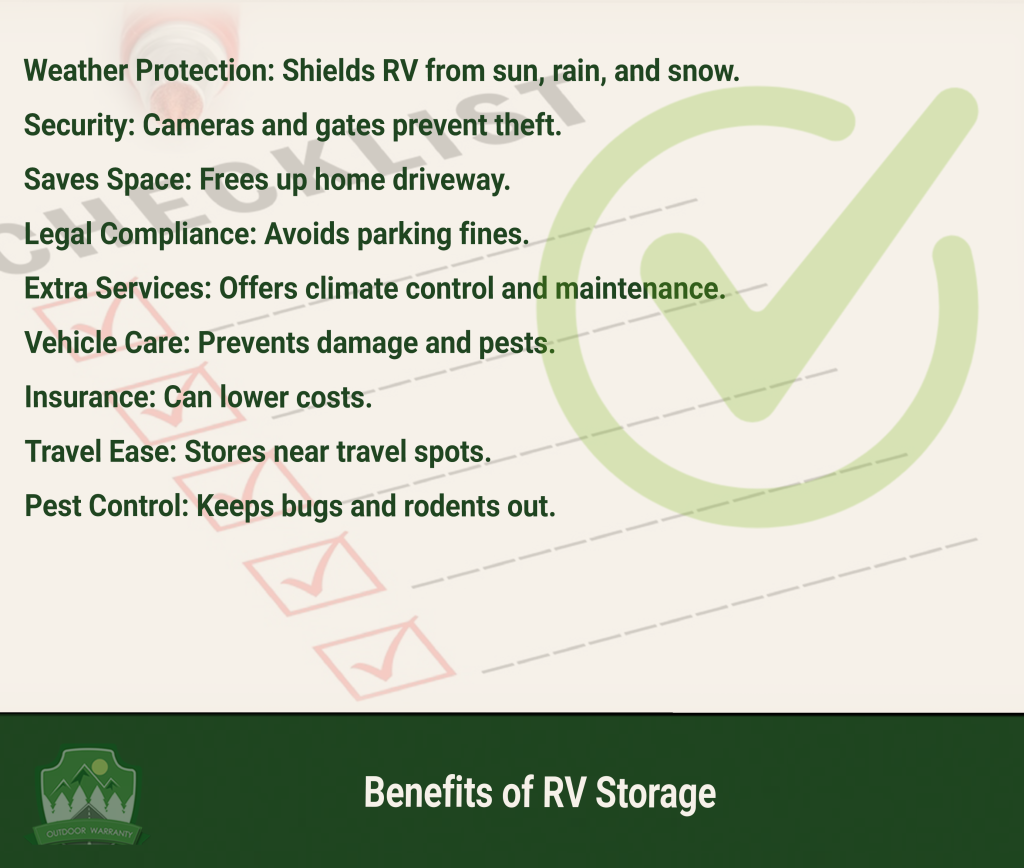
How to Prepare RV for Storage?
To prepare the RV for storage, follow the nine steps listed below.
- Cleaning is an essential first step in preparing an RV for storage. It removes dirt, debris, and food particles to prevent mold, odors, and pest infestations.
- Winterizing protects the RV’s plumbing system from freezing during cold months. Draining water systems and adding RV-specific antifreeze prevents damage caused by freezing temperatures.
- Disconnecting Batteries prevents power drainage and prolongs battery life during storage. Storing batteries in a cool, dry place and maintaining their charge is important for long-term care.
- Covering the RV protects it from weather damage, UV rays, and debris. A breathable cover prevents moisture buildup and helps maintain the RV’s exterior.
- Protecting Tires involves inflating them to the recommended pressure to avoid flat spots. Covering tires shields them from UV damage and slows down cracking and wear.
- Pest Prevention includes sealing openings and removing all food from the RV. Using deterrents like mothballs or essential oils helps keep pests away during storage.
- Ventilation is important to prevent moisture buildup and mold growth. Opening vents slightly allows airflow, while vent covers protect the interior from rain and pests.
- Fluid Checks ensure engine oil, coolant, and other fluids are topped off. The step prevents condensation and corrosion in the storage period.
- Choosing a proper storage location is vital for protecting the RV. The location must safeguard from harsh weather, UV rays, and potential theft. A secure RV Storage facility ensures the vehicle stays in good condition and offers peace of mind in the storage.